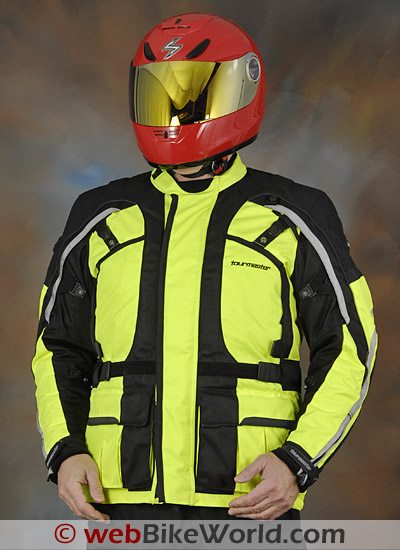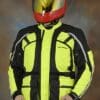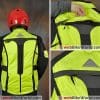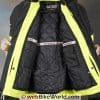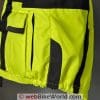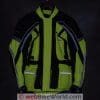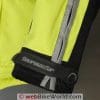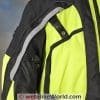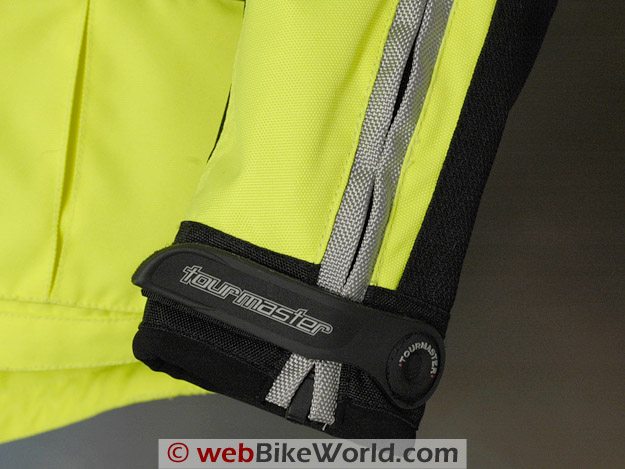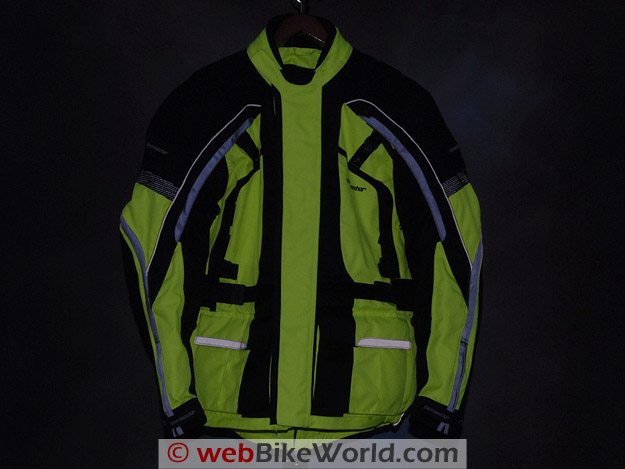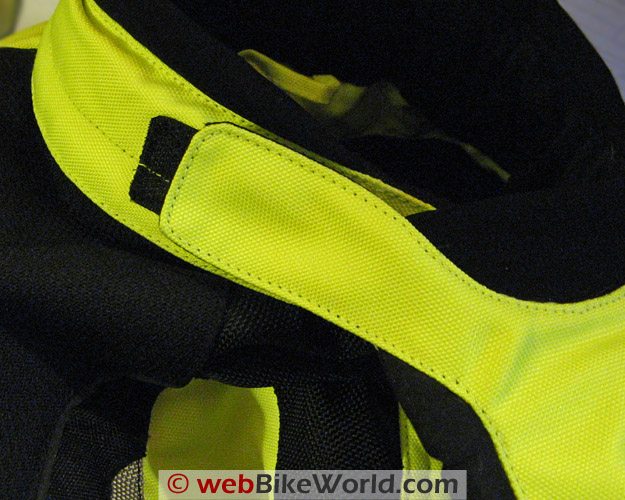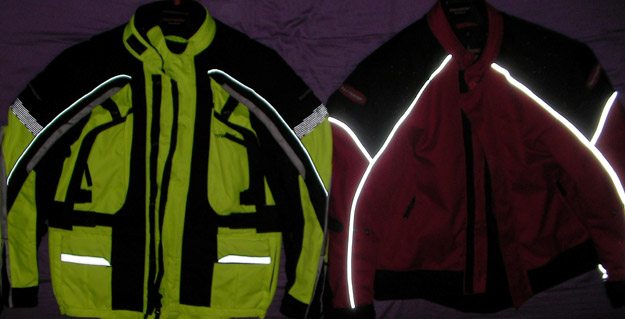The Tourmaster Epic is an excellent choice for an inexpensive, all-weather, all-season 3/4-length jacket.
The Tourmaster “Epic” jacket is the latest and greatest all-out, multi-season, full-blown, all-singing-and-dancing 3/4-length jacket currently occupying the top spot in the Tourmaster product line.
Like most Tourmaster products, this one is a heckuva bargain at a $279.99 list price — and it can be found for about $25.00 less than that on sale.
But before I get started, I have a disclaimer to reveal: I am and always have been a big Tourmaster fan, based on my past experience.
My feeling is that the price to performance ratio for the company’s clothing simply can’t be beat.
Tourmaster products may not be perfect, but what is and guess what? I’ll gladly give up that last ultimate 10% extra waterproofing capacity while I’m saving 50% and laughing all the way to the bank.
I’ll go as far as saying that the Epic jacket is, oh, about a 90% equivalent of any other big-name 3/4-length jacket I’ve tried.
The Tourmaster Epic is currently available in only two colors: basic black (yuck) and the eye-poppingly high-visibility yellow/green shown here.
As always, camera sensors get dazzled by this hue and the photos don’t do it justice. So you’ll have to take my word for it — this is one mind-blowing jacket color!
The Tourmaster Epic Jacket – Weight, Sizing and Initial Comments
The first thing I noticed about this Tourmaster Epic in size large is its weight. At 7 lbs. even (3.2 kg) it definitely feels, uh, built. Like a tank.
But I’m not really sure where all that weight is coming from because the jacket has an insulating liner only; it does not have a separate waterproofing liner.
The Epic jacket is fully 1.5 lbs. heavier than the same size Tourmaster Transition Series 2 jacket we reviewed in Part 2 of this 3-part series, and a massive 1 kilo heavier than the Rev’it Dragon reviewed in Part 1.
The Epic jacket shell is made from 600 Denier “Carbolex Plus” and 600 Denier “Ballistic Polyester”, according to Tourmaster. This material seems thicker and heftier than the material used in the Tourmaster Transition Series 2 jacket we reviewed in Part 2 of this 3-part series, so the “Plus” version of Carbolex may make up the weight difference from the Transition Series 2, which is listed as having the basic “Carbolex” instead, also at 600 Denier.
The Tourmaster Epic has larger sections of added abrasion-resistant material on the elbows and shoulders, and although I can’t prove it, the armor used in the Epic seems thicker, larger and more robust than that used in the Transition Series 2, which definitely seems more like a 3-season jacket than the 4-season heft of the Epic.
The size large fits like the Tourmaster Transition Series 2; that is, they both fit exactly as expected; slightly snug for a 43″ chest and 33″ to 34″ sleeve length with the liner inside. The insulation used in the Epic jacket, however, feels slightly thicker, thus the jacket gains about one size, rather than 1/2 size, when the liner is removed.
Also, the heft of the material and the weight of the jacket makes the Epic feel definitely bulkier than the Transition Series 2. That heft translates into a better jacket for colder riding conditions, and indeed I think the Epic would be the Tourmaster jacket of choice for winter riding. It’s not quite the equal of the Transition Series 2 for warmer weather, but the Epic still has very good air flow, all things considered.
In fact, both jackets have a feature set that is similar enough to consider them as two sides of the same coin with the Epic as the “Northern” version for riders with cold winters and the Transition Series 2 as the “Southern” version for riders with milder winters and longer/hotter summers.
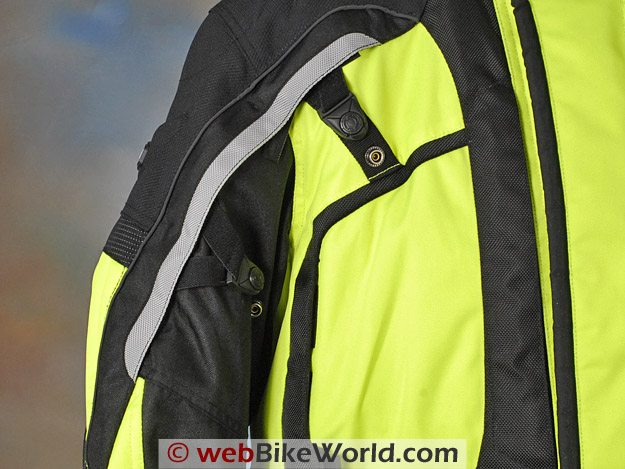
Tourmaster Epic Water Resistance
Waterproof capability seems to be one of the most important factors for many 3/4-length jacket owners, so let me address this issue first.
Waterproofing ability is one of the major differences between the Tourmaster jacket for $250.00 or so and a $500.00 “pro” level 3/4-length jackets. The more expensive varieties usually have a separate removable waterproof liner in addition to a removable insulating liner.
The waterproofing in the Epic comes from what the company calls a “Rainguard” waterproof barrier that is permanently bonded to the inside of the jacket shell, between the shell and the perforated inner permanent lining material.
Tourmaster says the Rainguard liner is both waterproof and breathable, but any garment like this will really only be as waterproof as the zippers and seams allow. I would caution anyone not to expect 100% waterproof capability in this jacket — ditto for pretty much any other motorcycle jacket also, as far as I’m concerned.
Some webBikeWorld readers have emailed us complaining that their jacket, claimed to be 100% waterproof, really isn’t. Not to offend, but I think this is a bit naive. If a jacket has a pocket or a seam — and what jacket doesn’t? — chances are that jacket will not be waterproof in a downpour.
It may not happen right away; and, in fact, the garment’s waterproofing ability is more a matter of when the water will penetrate the jacket and liner, not if. So it’s a matter of time — how long it will take before some water leaks in?
The bottom line here is that if you’re planning on riding for 8 hours in a monsoon, I believe it is unrealistic to expect any “waterproof” jacket to keep you perfectly dry. Buy a cheap rain suit to wear over your clothes in those conditions.
Also, remember that most or all 3/4-length jackets do not have a waterproof exterior, so even if the internal waterproof liner works, the jacket shell will absorb water and get very heavy and soggy. This is another good reason to carry a cheap rain suit on a trip.
Nevertheless, the Tourmaster Epic does a very good job in most of the weather conditions that the vast majority of motorcycle riders will face. The Rainguard liner actually has some open gaps underneath the claimed waterproof vent zippers, and here again, once there is an opening in the liner, all hope for total water integrity is lost, no matter what the company claims.
The Epic has a “hidden” feature that helps keep its owner dry also. It has a narrow zipper in the back of the collar that can be opened to allow the Tourmaster “Aqua Barrier” hood to be deployed.
The hood is made from a thin and comfortable material that fits over the rider’s head, under the helmet and keeps rain from running down the back of the jacket. An excellent feature which should be standard procedure on any 3/4-length (or other) jacket that is designed to work in variable weather conditions.
I rode with this jacket during the weird “7 Days of Rain” week we had in April of 2009 and although the jacket went from a heavy 7 lbs. to what felt like an additional 7 lbs. due to the water soaking the material, I stayed pretty dry. My pants were another matter however…
Reflectivity
The high-visibility color used in the Epic jacket is definitely an eye-popper, and it’s also extremely helpful in rainy, foggy conditions. Something about the color on this jacket makes is almost fluoresce when the sky is cloudy or in the early morning or evening hours as the sun goes down.
It’s pretty amazing actually — it almost seems like the fabric has a built-in lighting system. The color also appears to take on more lime green than yellow in cloudy conditions and as the sun sets, probably due to the different color temperature of the light at that time of day.
What doesn’t seem to work very well are the “Phoslite” reflective strips around the Epic jacket. We tried everything to get the material to pop under the studio flash, but as you can see in the photo above, it just looks dull, unlike any other jacket with reflective material that we’ve photographed for a webBikeWorld review.
I’m not sure why this is, because the Phoslite material should show some reflection under the camera flash, but it doesn’t. The jacket has reflective material on the pockets, in piping up along the sleeves and in the larger grey/silver sections on the sleeves and in the back.
We just can’t seem to get it to glow in the photos the way it should, and this normally is not a problem at all — in fact, it’s usually just the opposite, because the material wants to reflect all the time, which isn’t necessary or desirable for the normal photographs.
So I’m not sure if the reflective material works, or if it is less efficient than other types of material, or if it’s some technical problem that we haven’t considered. See the photos in our Rev’it Dragon review and in the Tourmaster Transition Series 2 review, which were taken under the same conditions at the same time, for an example of the reflectivity.
Other Interesting Features
The Tourmaster Epic jacket collar can be secured to a strip of hook-and-loop on the left-hand side of the neck, similar to the snap system used on the Transition Series 2. This holds the collar open when desired to allow air flow on to the neck. We described this with photos in the Transition Series 2 review.
The Epic jacket has another interesting feature that is also somewhat hidden. I didn’t discover it until I had the jacket on my lap one day before I put it on for a ride.
A hidden kidney waist belt lives inside the back of the jacket, under the inner perforated lining. There are open slit pockets in the jacket, just inside the plackets on either side, down at the bottom hem.
The waist belt snaps to the inside of the pockets, and when the snaps are released, the belt can be pulled around the front of the rider’s waist, where it can be snapped in place. It’s more of a waist belt that also holds the bottom of the jacket closer to the rider’s body to prevent air ingress, and it doesn’t seem to provide much back support.
But I’m not a big fan of the kidney belt anyway, because I’ve never tried one that seems to do much. It’s a device that perhaps works better for cruiser riders, with the more upright riding position.
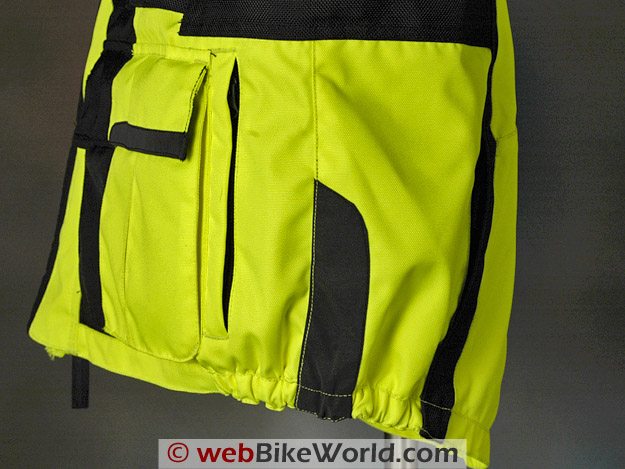
Tourmaster Epic Zippers, Closures and Adjusters
The Tourmaster Epic and the Transition Series 2 have very similar features, so some of the following may be a repeat from the Transition Series 2 review.
Zippers
The full-length front zipper on the Epic jacket shell is unlabeled but has a large Tourmaster zipper pull. The jacket has a single front zipper with large nylon or plastic teeth, and a larger folding placket covers the zipper in front. The placket is larger than the one used on the Transition Series 2.
One added feature on both jackets is the dual-pull on the zipper; it can open up or down and opening it up from the bottom allows the jacket to spread at the bottom and comes in handy when putting on boots.
Sleeve Cuffs
The cuffs on the Epic jacket use a hook-and-loop attachment system, similar to that used on the Rev’it Dragon and many other motorcycle jackets. It’s simple and it works and leaves a narrow profile at the cuff that helps the sleeve fit into just about any glove gauntlet.
The covering strip on the Epic sleeve cuffs is made from a type of flexible plastic, rather than cloth. One difference is that the sleeves on the Epic also have a vertical zipper to allow the cuffs to open wide.
The inside of the cuffs on the Epic jacket are lined with some type of rubbery-feeling fabric, not the corduroy of the Transition Series 2. This adds comfort to the sleeve cuff where it rubs against the rider’s wrist and it’s also used to line the neck. The material has a comfortable feel.
Adjusters
The Epic jacket features a wide adjustment strap at both sides at the waist under the arms. The band is hidden under a fabric covering with some elastic at the end. The adjusters work by pulling the band forward and securing it to the front of the jacket with hook-and-loop.
The combination of the waist adjusters and the elastic allow the jacket to be cinched to keep cold air from blowing up from underneath.
The adjusters used on both jackets are very similar. Both jackets have two adjusters, one in the forearm and one at the bicep. These are hard rubber covered snaps with a total of three each metal snaps on the sleeve body. The extra snap gives a good range of adjustment.
The Epic also has the Transition Series 2 adjuster snaps located at the upper front part of the shoulder at the collarbone on either side. These can be used to hold down the material at the front of the jacket when the shoulder vents are open to allow more air to flow in to the “scoop” vent.
The Epic does not have adjusters at the hem; instead, a strip of elastic is sewn into the hem to keep the jacket tight.
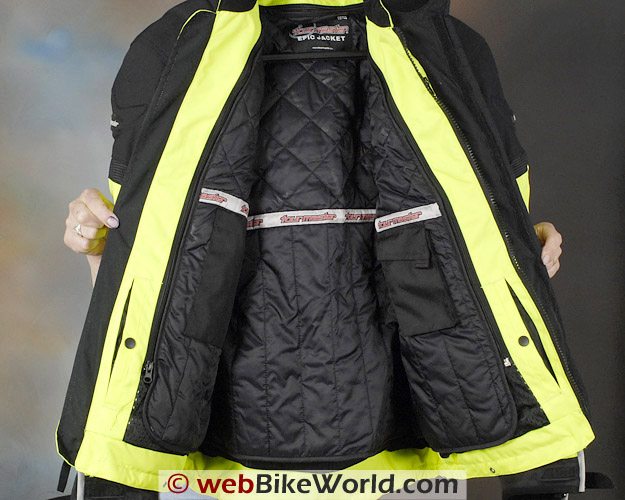
Insulation
The liner and the outer shell used in the Epic jacket appears to be good down to around 5 C (40 F) or so. Tourmaster says the liner used in the Epic jacket has 80 grams of 3M Thinsulate insulation.
The Epic and the Transition Series 2 have a very similar venting system, but the Transition Series 2 is definitely more comfortable when the temperatures rise. The Epic jacket, with its thicker material and apparently more robust waterproof liner, isn’t as good in hot weather, but very few 3/4-length, all-season jackets are.
The Epic’s insulating liner zips to the jacket with a single zipper up one side, around the neck and down the other side. It’s not a double zipper, so it opens from one side only.
The insulation continues down the sleeves and ends about 10 cm above the cuff, which helps to thin out the end of the sleeve and allows the jacket to slip nicely into a glove gauntlet.
Each sleeve has two snap attachments that fit over loops sewn into the inside of the sleeve to hold the ends of the sleeves in the jacket. The bottom of the liner at the lower section of the back also features two loops and snaps on the liner to hold it in place and to help prevent it from rising up the rider’s back.
Each loop is colored either white or black and matches the corresponding loop on the liner, which makes it easy to re-attach the liner and get the correct alignment.
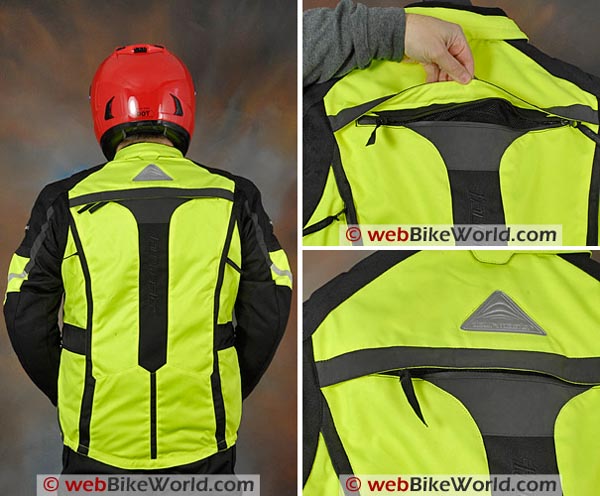
Ventilation and Air Flow
The venting system in the Epic jacket is also similar to that used in the Transition Series 2 jacket, with several large vents that can be held open to allow air flow.
The jacket features the same long 30 cm shoulder and upper arm vent on either side that opens with a (claimed) waterproof zipper. These vents can be held open by a separate section of hook-and-loop underneath, so they act as air scoops. We first experienced this type of arrangement on the Joe Rocket Ballistic 7.0 jacket.
The jacket also has four vertical vents, each approximately 23 cm long, in the chest. On the Epic, these are located under the black vertical bands located about half-way between the main zipper and the arms. These can also be held open with separate strips of hook-and-loop and they do feature waterproof zippers.
Two of the vertical vents are located at the outer section of the chest near the arms, and the other two in the center of the chest, just on either side of the zipper placket. These four vents are unusual for a jacket of this type and add to the excellent venting capabilities of the Transition Series 2 jacket.
And like the Transition Series 2, there’s a surprise, as you’ll see in the “Pockets” section below. The central vents also function as huge storage pockets!
Taking a tip from Aerostich and others, both the Epic and the Transition Series 2 also has a full-length rear vent in the upper back. It’s covered with a flap that has a strip of highly reflective material.
The combination of these vents provide excellent to outstanding air flow through the Transition Series 2 jacket shell that can be felt even with the insulating liner installed. In the Epic jacket, the effect is slightly muted due to the heavier liner.
One thing to note though when all the hatches are open is that on some motorcycles, the low pressure created when riding behind a fairing or even a small windscreen makes the rear of the jacket billow out. There’s a lot of air being forced in around the chest and it can’t always escape fast enough out the back. The pro to this con though is that this creates a pocket of air between the jacket and the rider, keeping things relatively cool.
Just be sure to realize one thing though; whatever water-resistant lining or material or treatment that Tourmaster put in both jackets, it does not cover the vent openings, so the vents are not sealed. However, this is actually good news, because I’ll take ventilation over a theoretical ultimate waterproof capability any day.
Overall, considering the heft and protection offered by the Epic, the ventilation (with the insulating liner removed and all vents open) is excellent for a 3/4-length jacket.
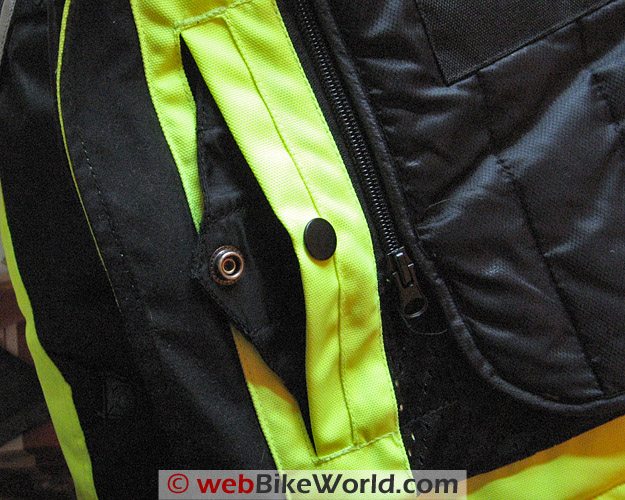
Armor, Protection and Padding
Tourmaster says that both the Transition Series 2 and the Epic include CE-approved removable armor. The Epic has a small section of armor at the shoulder and a longer section in the elbow. The elbow armor is notched at the sides to help it flex.
The jacket also features a relatively thin back pad. The absence of more robust armor is probably due to pricing considerations, but the upside is that the slightly smaller and thinner armor makes the jacket more flexible and comfortable than it might be otherwise.
Although we haven’t tried it, it may be possible to replace the existing armor or back pad with something more robust. Alternatively, the armor can be removed and the owner can wear something like the Velocity Gear Juggernaut armored shirt (review) underneath, which would probably provide more protection than any combination of jacket armor that could be fitted anyway.
The elbows and shoulders on the Transition Series 2 jacket do include some added material (the black sections on the jacket in the photos) that appear to be heavier than the tan part of the jacket shell, and these probably offer some added abrasion resistance.
Pockets
The Epic jacket features the same assortment of pockets as used in the Transition Series 2, so some of this is a repeat.
The jacket features two square pockets in the lower front acting as the main storage area. These are covered with a flap that uses both hook-and-loop and a rubber-covered metal snap, and they have a zipper underneath with a fabric zipper pull. These pockets feel like they are waterproof with a lining that is separate from the shell liner.
The vertical vents that are located in the center of the jacket, on either side of the central zipper were mentioned in the “Vents and Air Flow” section above. But these vents also hide a secret: they’re huge pockets!
The vent is opened with a zipper, and the vent opening can be kept open with a double section of hook-and-loop. Reach inside and the pockets are lined with mesh and they’re about 20 cm wide by 30 cm deep. Excellent!
The left sleeve has a handy little zipper covered pocket just above the cuff. Some spare toll booth change or an ID badge can be stored here. The pocket has a nice hidden surprise: an attached elastic lanyard with a spring-loaded hook on the end which can be attached to a set of keys or even a small change purse.
The jacket has a semi-hidden pocket at the lower back that opens with vertical zippers on either side. It’s a fairly large pocket at about 25 cm by 30 cm. The insulating liner can be stuffed in there if necessary, but it’s probably better suited for a windbreaker or wind-blocking vest. It will also easily hold a few bottles of water.
On the inside, the insulating liner features a square patch pocket on the right, inside the chest. This secures with hook-and-loop across the top. The left-hand side features two nice pockets; one for a cell phone and the other sized for a wallet. These also have a hook-and-loop flap with a nicely formed pull sewn to the front.
All three of these pockets are repeated on the inside of the jacket liner, meaning that whether the insulation is in or out, the owner has use of three nice internal pockets.
One more zippered pocket lives just inside the left placket. It appears to be waterproof and it’s the perfect place to stow a wallet.
Style and Comfort
The Epic jacket has more up-to-date styling than previous Tourmaster jackets. Like the Transition Series 2, the jacket is designed with an Enduro flavor, perhaps not quite as “Enduro-ish” as the former, but it also looks good and it looks rugged.
Conclusion
The Tourmaster Epic is an excellent choice for an inexpensive, all-weather, all-season 3/4-length jacket. My wild guess says it does something like 90% of jackets costing nearly twice as much, so the Epic is the right product at the right time in today’s economy.
Like the Transition Series 2, the styling, the eye-popping high-visibility color and the excellent air flow are a bonus, and the price is definitely right. But the Epic definitely feels more solid and adds that fourth season — winter — to its protective capabilities.
More wBW Motorcycle Clothing Reviews
| wBW Review: Tourmaster Epic Jacket | |
|---|---|
| Manufacturer: Tourmaster | List Price (2009): $279.99 |
| Colors: Black or High-Visibility Yellow. | Made In: China |
| Sizes: S to XXXL | Review Date: May 2009 |
|
Note: Item was provided by a retailer, distributor or manufacturer with these Terms and Conditions.
|
|
Owner Comments and Feedback
See details on submitting comments.
From “E.H.” (December 2011): “I just purchased this jacket and can’t wait to use it this Spring. Your review was very helpful. However, you mention a hidden pocket on the left sleeve. This does not exist on the Epic but is featured in the Tourmaster Transition Series 2 jacket.
I searched high and low and could not find the pocket on my jacket. The Tourmaster website shows that the pocket is on the transition not the Epic jacket. Keep up the great work!”
Editor’s Note: Features often change during the production run, so it’s also possible that Tourmaster eliminated the pocket in later versions.
From “O.W.” (4/10): “Your review of the Tourmaster Epic jacket was key in my decision to purchase it. Your review noted two areas were of concern to me, however, that made me hesitate in my purchase. The concerns turned out to be unwarranted.
The first concern was your note regarding difficulty in getting the Phoslite to light up for you, which made me wonder if there was any Phoslite. In the attached photo, I photographed the Epic next to the Tourmaster Flex 2 jacket, which I knew to have excellent Phoslite application. You can see that the Epic does light up. Upon further inspection of the photos you posted, I can see the potential confusion.
The areas where Phoslite were added were not white or grey in the daytime. In fact, for the Epic jacket, the Phoslite was applied to black fabric. The jacket flap trim, for example, is black in daylight but shows up white in the photo with the studio flash, thus indicating that the Phoslite is indeed working. So although the Epic Phoslite application appears to be much smaller in area and less brighter, it does appear to work.
Secondly I was concerned that the high impact areas utilized “only” 600 denier fabric according to the web site information and your review. According to the tag attached to my jacket, the high impact areas are 1680 denier. (This might account for the Carboflex “plus” designation). Perhaps a clarification from Tourmaster is in order. Thanks again for the great review.”
From “J.T.” (6/09): “I purchased an epic jacket in Hi Viz yellow in April of 09. By May of 09 with less than 3,000 miles I had to return it because the stretch material on the sleeves was fraying. The retailer replaced it with no questions asked.
With less than 500 miles on the 2nd jacket the same thing is happening. I thought I had found the perfect jacket to wear for long trips in all kinds of weather but this is not the right one. I contacted Tour Master and they told me to take it back to the retailer. At this point, I think I am going to opt for a refund and look at the Olympia AST Jacket in Hi Viz yellow (review).”
From “E.L.” (5/09): “Upon looking at the site I couldn’t help but noticing a new review of Tourmaster Epic Jacket – which features the same bright colours that Road Sack has, so I read the review. Fantastic details in the review, love your work.
Re: The silver ‘Phoslite’ material along the arms not reflecting, I felt I could help contribute.
From experience and the photos it certainly look like the material is not of reflective fabric type, it is what I call ‘grey coloured fabric’. And that’s all it is.
From the close ups it does NOT looks like a reflective material nor does it look like it’s been coated with anything special. Normally, fabric has to be coated with polymer paint for it to take the on ability to be reflective to light. When they are they’re usually of a rubberised surface and you won’t see the weaves of the fabric.
The ‘Phoslite’ name is most likely a marketing gimmick unfortunately or not applicable to those runners along the arm sections.”
From “J.M.” (5/09): “A huge factor in how dry a jacket will keep you is how tall is the windshield. My current jacket, an older Kilimanjaro, keeps me perfectly dry regardless of the conditions behind the fairing of the K75RT, but I’ll be damp on the Dakar.


